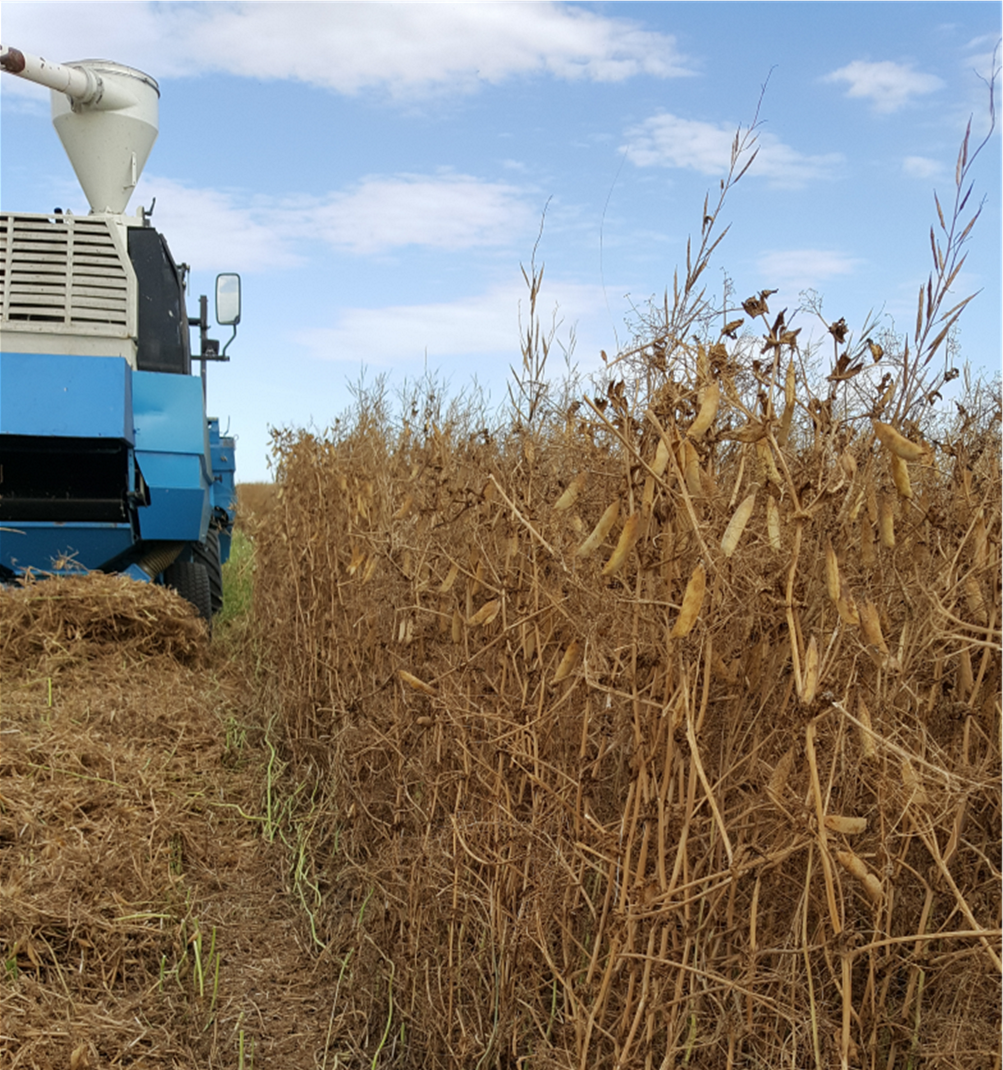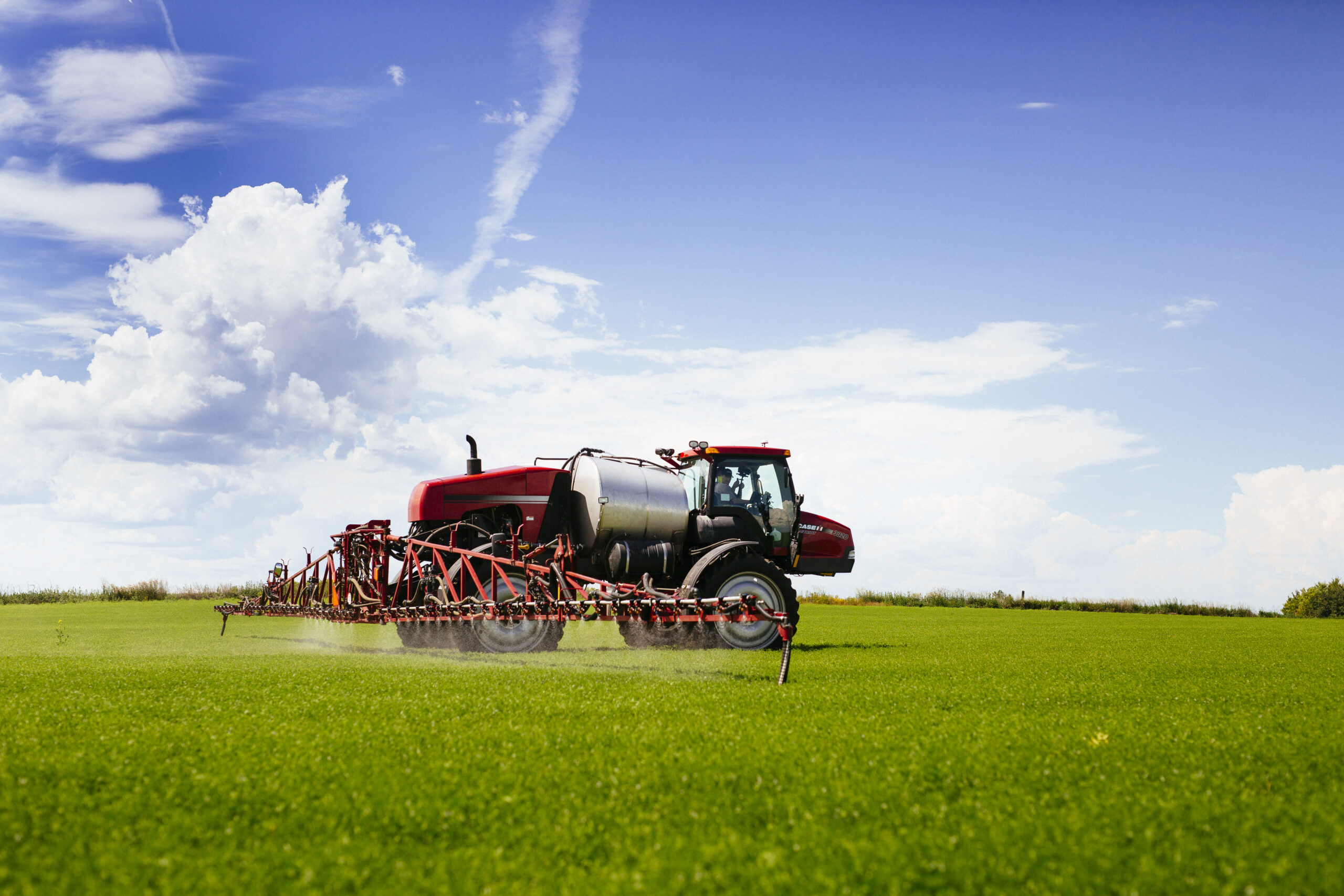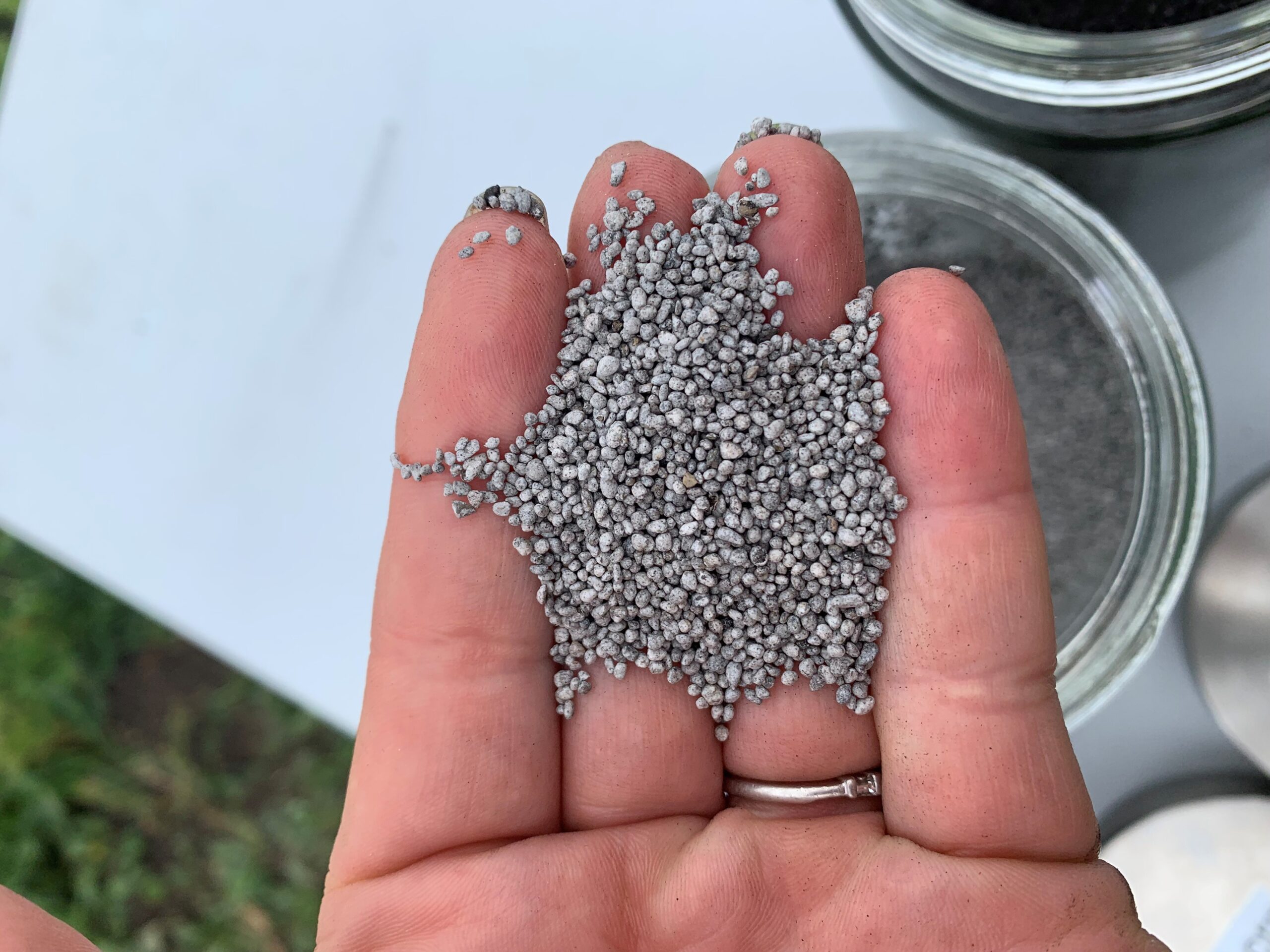Research Conducted by: Lana Shaw, South East Research Farm
Background
Intercropping pulses with other crops can provide benefits such as reduced lodging, improved weed competition, and reduced disease pressure. Under situations where difficult agronomic issues like herbicide-resistant weeds, root rots, and unusual rainfall patterns have been destabilizing crop production, intercropping offers a unique solution for managing production risk.
Purpose
Evaluate the potential for intercropping peas and lentils with brown or yellow mustard.
Design of Experiment
This project was carried out by the South East Research Farm (SERF) at Redvers, Saskatchewan in 2017. The trial was structured as a randomized complete block design, with four replicates, and was seeded on May 12 into wheat stubble. Varieties for the crops grown are listed in Table 1.
Nitrogen fertilizer was broadcast prior to seeding the mustard monocrops at 67 kilograms per hectare (kg/ha) or 59 pounds per acre (lb/ac), and in the intercrops at 45 kg/ha (40 lb/ac). No nitrogen was added to pulse monocrops.
Mustard was seeded at 3.5 kg/ha (3.1 lb/ac) in intercrop and 6.2 kg/ha (5.5 lb/ac) in monocrop. Pulse seeding rates were to target plant populations of 130 and 70 plants per square metre (m2) for monocrop peas and lentils, and 98 and 53 plants/m2 for peas and lentils intercropped with mustard. Seeder error resulted in higher (greater than two times) seeding rates for pulses, and actual plant populations averaged 290 and 156 plants/m2 for the pea monocrop, and 218 and 117 plants/m2 for peas and lentils intercropped with mustard.
The trial was harvested on August 22, and the yield was adjusted for moisture. Crops were separated to obtain individual crop yields from the intercrop.
Table 1. Crop and variety grown in the trial.
| Crop | Variety |
|---|---|
| Yellow Peas | CDC Amarillo |
| Green Peas | CDC Greenwater |
| Small Red Lentils | CDC Maxim |
| Large Green Lentils | CDC Impower |
| Yellow Mustard | Andante |
| Brown Mustard | Centennial |
Table 2. Impact of intercropping on height and lodging of pulse crops.
| Crop | Height (centimetres) | Lodging (1 to 10) |
|---|---|---|
| Yellow Peas | 99.7 | 5.2 a |
| Yellow Peas Intercrop Average | 106.4 | 1.9 b |
| Green Peas | 104.2 | 3.3 |
| Green Peas Intercrop Average | 102.5 | 2.0 |
| Large Green Lentils | 50.7 | 8.3 a |
| Large Greens Lentil Intercrop Average | 61.1 | 3.7 b |
| Small Red Lentils | 45.8 | 2.3 |
| Small Red Lentils Intercrop Average | 52.1 | 2.2 |
| Least Significant Difference (LSD) | Not significant | 1.7 |
Lodging scale of 1 to 10 with 1 = lowest lodging and 10 = most lodging. Mustard intercrops were averaged as there was no significant impact of mustard type.

Source: South East Research Farm
Results
Plant height measurements taken near maturity were not statistically different between monocrop and intercropped pulses, but there was a general trend of higher pulse height under intercrop, with the exception of green peas (Table 2).
Lodging ratings near maturity did show a significant reduction with yellow peas and large green lentils when grown in intercrop. Green peas did have a slightly lower lodging rating in the intercrop compared to the monocrop, but it was not statistically significant. These results suggest improved lodging could be a benefit to intercropping pulses.
Grain yields were separated for each crop and land equivalent ratios (LER) calculated.
LER = (Pulse intercrop/Pulse monocrop) + (Mustard intercrop yield/Yellow mustard monocrop yield)
A land equivalent ratio greater than one means there was higher combined yield per unit area in the intercrop, compared to growing the crops separately.
Yield results from peas are shown in Table 3. With yellow peas there was no impact of intercropping with yellow mustard, as yields were similar between the monocrop and intercrop. With brown mustard, the yield of yellow peas was actually higher in the intercrop than in the monocrop. There is no explanation as to why the intercrop would have higher pea yield than the monocrop.
Green peas responded slightly different, as they did have slightly lower yields when grown under intercrop with brown mustard, compared to the monocrop.
Mustard yields were higher with green peas compared to yellow peas, suggesting yellow peas are slightly more competitive. Yields of mustards were greatly reduced compared to the monocrop.
Table 3. Yield results from pea and mustard intercrops.
| Crops | Pea Yield (bu/ac) | Mustard Yield (bu/ac) | Combined Yield | |
| bu/ac | LER | |||
| Yellow Peas | 55.7 b | – | 55.7 | 1.00 |
| Yellow Peas + Yellow Mustard | 56.4 b | 2.1 | 58.4 | 1.18 |
| Yellow Peas + Brown Mustard | 68.9 a | 1.9 | 70.5 | 1.33 |
| Green Peas | 67.8 a | – | 67.8 | 1.00 |
| Green Peas + Yellow Mustard | 59.5 b | 3.1 | 62.4 | 1.12 |
| Green Peas + Brown Mustard | 63.2 ab | 2.8 | 65.5 | 1.08 |
| Yellow Mustard | – | 13.9 | 15.5 | 1.00 |
| Brown Mustard | – | 19.4 | 19.4 | 1.00 |
Table 4. Yield results from lentil and mustard intercrops.
| Crops | Lentil Yield (bu/ac) | Mustard Yield (bu/ac) | Combined Yield | |
| bu/ac | LER | |||
| Large Green Lentils | 38.5 | – | 38.5 | 1.00 |
| Large Green Lentils + Yellow Mustard | 36.8 | 6.0 | 42.8 | 1.42 |
| Large Green Lentils + Brown Mustard | 35.1 | 7.2 | 42.3 | 1.29 |
| Small Red Lentils | 49.5 | – | 49.5 | 1.00 |
| Small Red Lentils + Yellow Mustard | 38.5 | 7.0 | 45.5 | 1.32 |
| Small Red Lentils + Brown Mustard | 40.1 | 8.1 | 48.2 | 1.23 |
| Yellow Mustard | – | 13.9 | 13.9 | 1.00 |
| Brown Mustard | – | 19.4 | 19.4 | 1.00 |
This is likely due to the heavy seeding rate of peas, resulting in higher competition. These results suggest that there is no negative effect on yellow pea yields when intercropped with mustard at the higher (greater than two times) pea seeding rates.
Land equivalent ratios with both yellow and green peas is greater than one when grown under intercrop. This indicates pea and mustard intercrops can produce more grain per unit area, compared to monocrop production systems under the seeding rates and management practices used in this trial.
Lentil yield results (Table 4) show little impact of intercropping large green lentils with mustard, but greater impact with small red lentils. The yield of mustard was less affected by lentils than by peas, which supports lentils being less competitive than peas. Small red lentils appear to be less competitive than large green lentils based on a larger decrease in yields of lentils under intercropping, and the higher yields of mustard.
Land equivalent ratios with both large green lentils and small red lentils is less than one for all intercrop systems. This suggests lentil and mustard intercrops can produce more grain per unit area, compared to monocrop production systems, under the seeding rates and management practices used in this trial.
Days to maturity were not statistically different between monocrop and intercropped treatments for both pulses and mustards.
Thousand kernel weight of yellow mustard was significantly reduced under intercropping, while pea and lentil seed size increased in the majority of the intercrops. Crop competition could be impacting seed size, as yellow mustard seed size was the most reduced with yellow peas, compared to green peas. This could also be related to nitrogen levels, as there were higher nitrogen rates in the mustard monocrops than intercrops, and higher nitrogen in the pulse intercrops compared to pulse monocrops.
Root rot disease incidence was evaluated in this project, but there was no statistical differences. Overall there was a trend of lower incidence of root disease in most of the intercrop systems.
The drier conditions in 2017 may have limited root rot infection and incidence.
Economic Implications
The intercrop treatments were economically superior to the monocrop pulses based on the prices indicated, with the exception of green peas intercropped with yellow mustard (Table 5).
Yellow peas were more profitable than green peas and large green lentils more profitable than small red lentils in the intercrop systems. Brown mustard intercrops had higher returns than the yellow mustard intercrops with peas, and were variable with lentils.
Recommendations Based on Trial
Intercropping of peas and lentils can be done successfully with yellow and brown mustard. Higher seeding rates of the pulses did allow more competition of the pulse crop with the mustard, and dramatically affected the mustard yields. The mustard did improve the standability of pulses (particularly yellow peas and large green lentils), which can be attractive from a harvesting perspective.
Other work intercropping pulses with mustard suggests care must be taken with mustard seeding rates, as too high of mustard populations can dramatically reduce pulse yields. The unplanned higher seeding rates with pulses in this study may have turned out to have a positive contribution to the final results, by allowing the pulse crops to be more competitive. Organic systems use higher seeding rates to help improve competition with weeds. As limited weed control options are available with this intercrop, the higher seeding rates may have also influenced weed competition.
Concern with mustard contamination in pulses from a marketing perspective should be considered prior to engaging in this type of intercrop. Separating the mustard from the pulses prior to storage is recommended.

Source: South East Research Farm
Table 5. Economics of intercrops compared to monocrops.
| Crops | Seed and Nitrogen Cost ($/ac) | Net Returns ($/ac) | Difference to Pulse Monocrop ($/ac) |
|---|---|---|---|
| Yellow Peas | $67.28 | $322.30 | |
| Yellow Peas + Yellow Mustard | $71.89 | $365.93 | $43.63 |
| Yellow Peas + Brown Mustard | $71.82 | $444.02 | $121.72 |
| Green Peas | $90.96 | $485.50 | |
| Green Peas + Yellow Mustard | $88.38 | $480.33 | -$5.16 |
| Green Peas + Brown Mustard | $88.32 | $497.58 | $12.09 |
| Large Green Lentils | $89.32 | $534.74 | |
| Large Green Lentils + Yellow Mustard | $87.37 | $629.92 | $95.18 |
| Large Green Lentils + Brown Mustard | $87.31 | $607.23 | $72.49 |
| Small Red Lentils | $73.69 | $460.58 | |
| Small Red Lentils + Yellow Mustard | $75.37 | $481.76 | $21.19 |
| Small Red Lentils + Brown Mustard | $75.31 | $499.10 | $38.53 |
Based on yellow peas at $7 per bushel, green peas at $8.5 per bushel, large green lentils at 27¢ per pound, small red lentils at 18¢ per pound, yellow mustard at 36¢ per pound, brown mustard at 35¢ per pound, and nitrogen at 45¢ per pound. Seed costs are based on certified seed prices at two times the rate of commercial prices.
Acknowledgements
Project Lead: Lana Shaw, P.Ag, South East Research Farm, Redvers
Recognition: Brennan Weins—Hershel, Derek Axten—Minton, and Sally Sutter—Redvers, for contributing seed and inoculant to the project.
Thanks to Southland Pulse in Estevan and Viterra in Carnduff for grading the peas and lentils.




